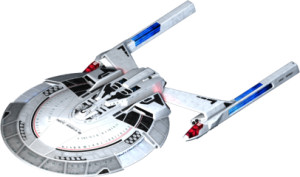| Borodin Class |
| TYPE |
| Borodin Class Battlecruiser |
| COMMISSIONED |
| 2386 - present |
| UNIT RUN |
| USS Borodin • NCC 39214-B • USS Kumari • NCC 80407 • USS Discovery • NCC 80408 USS Ontario • NCC 80409 • USS Juneau • NCC 80410 Plus an additional 86 vessels. The class remains in production. |
| LENGTH: 510 m BEAM: 156 m HEIGHT: 68 m DECKS: 18 |
| DIMENSIONS |
| CREW |
| 450; 4000 evacuation limit |
| ARMAMENT |
| 6 type-XI phaser arrays, total output 65,000 TeraWatts 4 pulse-fire quantum torpedo tubes +300 torpedoes |
| DEFENSE |
| Regenerative shield system, total capacity 3,995,000 TeraJoules Duranium/tritanium double hull +4.2cm density ablative armor High Level Structural Integrity Field |
| PROPULSION |
| NORMAL CRUISE: Warp 8.5 MAXIMUM CRUISE: Warp 12.0 MAXIMUM SPEED: Warp 12.5 for 6 hours |
| STRENGTH INDEX Galaxy Class = 1000 |
| BEAM FIREPOWER: 1,300 TORPEDO FIREPOWER: 1,000 WEAPON RANGE/ACCURACY: 1,290 SHIELD STREGNTH: 1,329 HULL ARMOR: 1,030 SPEED: 829 MANEUVERABILITY: 4,200 OVERALL: 1,175 |
| DIPLOMATIC GRADE |
| 6 |
| HULL LIFE |
| 100 years |
| REFIT CYCLE |
| MINOR: 1 year STANDARD: 2 years MAJOR: 10 years |

| NOTES |
| The Borodin class starship was first developed in the 2370's. With conditions gradually deteriorating in the Gamma Quadrant, Starfleet wanted a vessel capable of exploring the region without fear from the Dominion and the Jem'Hadar. Their solution was the powerful Borodin. Unfortunately, the Federation found itself at war with the Dominion just months before the Borodin was slated to begin production. Starfleet's renewed need for warships prompted the Borodin to be shelved until the 2380's, when exploration in and around the Romulan Neutral Zone became a treacherous proposition. The Borodin class namesake was launched in 2386. Though capable in tactical situations, much of the Borodin's equipment is devoted to science. It possesses numerous sensor arrays and newer Borodin class starships have been outfitted with advanced temporal matrices. |
| ACKNOWLEDGEMENTS |
| The Borodin-class model used throughout this site was created by Rick "Hobbes" Snider. This page was created using information from the Daystrom Institute Technical Library (www.ditl.org) |




